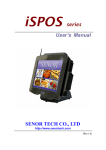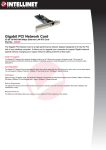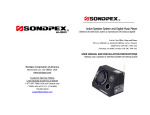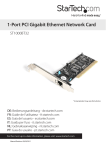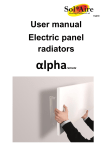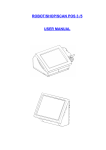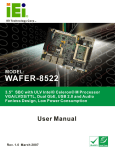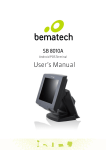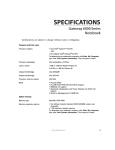Download User`s Manual Senor Tech Co., Ltd
Transcript
APOS User’s Manual Senor Tech Co., Ltd http://www.senortech.com TRADEMARKS and ACKNOWLEDGEMENTS All brand names and trademarks used in this manual are the properties and registered brands of their respective owners TABLE OF CONTENTS 1. SPECIFICATION...…………………………………………. 3 2. TERMINAL OVERVIEW AND OPERATION……………. 8 2.1 LCD Angle Adjust..………………………………….. 10 2.2 Touch Screen………………………………………… 10 2.3 Removable Hard Disk Drive..……………………… 11 2.4 Connectors…………………………………………… 12 2.5 Power on………………………………………………. 14 2.6 Battery Replacement………………………………... 15 2.7 VFD Replacement………………………………….… 17 2.8 Card Reader Replacement………………………………….. 18 2.9 Wireless LAN Card Installation...…………………. 18 2.10 CF Card Installation and Removal.……………... 20 2.11 Modem Card Installation………………………….. 21 2.12 Cashdrawer Board Installation...………………... 21 3. INSTALLATION……………………………...…………….. 22 3.1 Pre-installation………………………………...…….. 22 3.2 Mounting……......…………………………………….. 23 4. REGULAR MAINTENANCE..……………..……...………. 26 4.1 Cleaning……………………………………………….. 26 4.2 Touch Screen…....…………………………………… 26 5. TROUBLESHOOTING……...……………..………………. 27 5.1 General Troubleshooting…………………………... 27 5.2 LCD Troubleshooting…..……………………..….… 28 5.3 Disk Driver Troubleshooting…….………………… 28 5.4 RAM Troubleshooting…….………………………… 29 5.5 Serial Port Troubleshooting……..………………… 29 5.6 Error Messages………….…………………………... 29 CAUTION............................................................................ 30 PRECAUTION…………………………………………………. 31 2 APOS User’s manual 1. SPECIFICATION Overall Dimensions 3 APOS User’s manual Weight: 9 Kg EMC: CE、FCC Compliant、CCC Safety: UL、CE、TUV CPU: Micro-FCPGA Intel Celeron M CPU 1G/1.5G、Intel P4 M 1.8GHz 4 APOS User’s manual System Chipset: Intel 852GM/855GME Chipset: BIOS: Award BIOS, 2M Support ACPI Function Standard I/O: 1 × PS/2 Port (Keyboard /Mouse) 4 × USB 2.0 Port 1 × VGA Port 1 × LAN Port 1 × Audio Port 1 × MIC Port 1 x Compact Flash type II socket for CF card 4 × RJ-45 Com Port (COM3 ~ 6) System Memory: Two DDR SODIMM, support up to 1GB DDR 200/266 SDRAM Note: For Intel 852GM - DDR200/266 DIMM modules, Max.2GB For Intel 855GME - DDR266/333 DIMM modules, Max.2GB Ethernet: Realtek RTL8110SC (10/100/1G) Ethernet Controller Supports wake-on-LAN function VGA: Intel 852GM/855GME built-in Intel extreme Graphics 2 Intel Dynamic Video Memory up to 64MB shared with system Audio Interface: ICH4 built-in Audio controller + AC97 Codec ALC655 USB Interface: ICH4 built-in USB 2.0 host controller supports 6 ports, use 4 ports 5 APOS User’s manual Hard Disk Drive 2.5" Removable HDD Operator Display Size Active Area Resolution Display Mode Contrast Ratio Luminance Touch Screen Technology Resolution Activation Force Linearity Transparency Surface Hardness Interface MTBF 15” (diagonal) 304.1 mm (H) x 228.1 mm (V) 1024 (H) x 768 (V) x R,G,B Normally White 500:1 typ. 250 cd/m² typ. 5 Wire analogue resistive Chemically strengthened backing glass. 4096 x 4096 points 5.5g 62.0% 75% 2H RS-232 Serial 1,000,000 touches / spot Customer Display (Option) Display Method Vacuum Fluorescent Format 40 Characters (20 Characters x 2 Rows) Display Color Blue Green Brightness 700 cd/m² Viewing Angle 88 - 358 Character Font 5 x 7 dot matrix Character Size 9.2mm x 6.4mm Character Pitch 8.3mm Character Type 96 Alphanumeric characters 13 International character sets 1 User defined character set Interface Hardwired to Com1 - EIA RS232C Baud Rate 4800bps, 9600bps selectable by dip switch Data Bits 8 Parity None 6 APOS User’s manual Stop Bits 1 MTBF (Power on time) 25000 hours Power Supply Input Voltage Input Frequency Input Current Output Voltage Operating temperature 100 ~ 240Vac 47 ~ 63Hz 100-240Vac 1.5A +19Vdc 3.2A 0°C to 40°C Size 120mm(L) x 60mm(W) x 38mm(H) Battery Typical Capacity Nominal Voltage Discharge Cut-off Voltage Maximum Charging Voltage Max Charging Current Max Discharging Current The end of charge condition Operating temperature Weight of battery pack 2150 mAH 14.4V or more (open circuit voltage) 12V 16.8V 1000mA 4000mA 200mA Charge: 0~ +45°C 85%RH Max Discharge: -10~+60°C 85%RH Max 240 grams or less Standard charge is defined by charging for 2.5 hours at 16.8V of constant Voltage and 1.0A Of constant current at 23±2°C. Standard discharge is defined by discharging at 700mA down to 12V at 23±2°C. Note: Specifications are subject to change without notice. 7 APOS User’s manual 2. TERMINAL OVERVIEW AND OPERATION The APOS is a Point Of Sale / Information terminal with all major functions housed in one single unit. Features : 15” LCD Operator Display with Automatic Tilt Mechanism Touch Screen 20 character x 2 line VFD Customer Display (option) Removable Hard Disk Drive x Serial Ports 1 x Network Port 4 x USB Ports Audio Output MIC port Easy Installation Easy Maintenance Overview - APOS 8 APOS User’s manual 9 APOS User’s manual 2.1 LCD Angle Adjust In order to accommodate various operator preferences and lighting conditions, the APOS is equipped with an operator tilt mechanism. Two buttons are located behind the upper left-hand edge of the Operator LCD. The uppermost button tilts the screen UP while the lower tilts the screen DOWN. The tilt movement is limited to a minimum of 30 degrees and a maximum of 70 degrees. To adjust the viewing angle, press and hold the UP or DOWN button as required until the best viewing angle is found or the LCD reaches its maximum or minimum limit. 2.2 Touch Screen The touch screen is a 5 wire analog resistive, mounted on a chemically strengthened backing glass, with a resolution of 4096 x 4096 touch points. The APOS is designed so that the application accepts all user input via the touch screen. Drivers are provided which allow the touch screen to emulate mouse operation; therefore most mouse driven applications will accept input from the touch screen. 10 APOS User’s manual 2.3 Removable Hard Disk Drive The removable hard disk is located left side of panel. The following drawings illustrate removal procedure. Caution: A. The HDD must be fitted with HDD Guides on both edges. B. Do Not insert the HDD into the Apos without the HDD Guides installed or damage to the HDD and/or the Apos will occur. C. The Apos power must be switched off before inserting or to removing the HDD 11 APOS User’s manual 2.4 Connectors All connections are located on the underside of the unit. Base and I/O cables 12 APOS User’s manual Connector locations 13 APOS User’s manual Base cable pad 2.5 Power on The Main Power Switch is located behind the left side of LCD front panel. Ensure it is switched to the “ON” position (Stand-by) before use. Turn on the unit by pressing the “Push ON Switch” located under the SENOR Logo on the front of LCD, turn off the unit by pressing and holding the switch for 3 seconds. When connected to an AC source, the Power Mode LED will illuminate automatically. The unit’s mode can be determined by the Power Mode LED color. 14 APOS User’s manual 2.6 Battery Replacement To remove the battery, remove the 4 screws under the left side panel. • The battery will last for approximately 30min when power is disconnected. • Battery recharge should take approximately 2 hours, (the battery recharge can proceed even in Stand-by mode). • Remove the battery from the APOS if it will not be used for an extended period. • The APOS Sleep Mode function supports Low Battery Suspend to Disk. Caution: 1. Do not leave the power switch in the ON position (Stand-by) with the AC power source switched ODD or Disconnected. In this situation the battery will continue to supply power to the unit, causing it to discharge over a period of time. If the AC power source is to be removed for a period greater than 24 hours (e.g. Storage, shipping) ensure the APOS power switch is in the OFF position to avoid damage to the battery. 2. RISK OF EXPLOSION IF BATTERY IS REPLACED BY AN INCORRECT TYPE. DIPOSE OF USED BATTERIES ACCORDING TO INSTRUCTIONS OR LOCAL REGULATIONS 15 APOS User’s manual Procedure: Unscrew the battery cover retaining screw, remove the battery cover, and lift up battery connector. Fit the battery into the battery compartment. 16 APOS User’s manual Connect the battery to the cable. Sit the connector into its holder as shown and replace the battery cover. 2.7 VFD Replacement Take the cover off and insert the VFD set, use two M3 screws to secure the VFD onto the unit. The VFD is internally connected to Com Port Com1. Caution: To install or to withdraw VFD, power must be switched off. 17 APOS User’s manual 2.8 Card Reader Replacement Take the cover off and insert the Card Reader Set, use two M3 Screws to Secure the Card Reader into the unit. If a keyboard device will be connected, switch the Master / Slave Switch on the rear of the Card Reader to the Slave position. If a keyboard device is not connected, switch the Master / Slave Switch on the rear of the Card Reader to the Master position. Caution: To install or remove the Card Reader, the power must be switched off. 2.9 Wireless LAN Card Installation 2.9.1. Insert wireless LAN card into the unit. 18 APOS User’s manual 2.9.2 Remove Antenna Cover from chassis. 2.9.3 Install the Water Sealing Washer and Antenna. Connect the Antenna Connector to Wireless LAN card. 19 APOS User’s manual 2.10 CF Card Installation and Removal 2.10.1 Insert CF card as diagram (1). Diagram (1) : CF card installation 2.10.2 Remove the CF card by pressing black button as indicated. 20 APOS User’s manual 2.11 Modem Card Installation Install Modem card as shown in diagram (2). Attach plastic standoffs followed by the plastic screws. Diagram (2) : Modem card installation 2.12 Cashdrawer Board Installation (Model: GMB-A232CDV1) Install Cashdrawer board as shown in diagram (3). Attach plastic standoffs followed by the plastic screws. Diagram (3) : Cashdrawer board installation. 21 APOS User’s manual 3. INSTALLATION It is important that before installation the APOS terminal's position and environment be considered. 3.1 Pre-installation Location Ensure that as with any computer equipment, the APOS terminal is positioned in a clean and well-ventilated area away from direct sunlight Operator’s Comfort and Safety Operator comfort and safety should always be of the highest priority when deciding on the location and layout of the APOS system. Of consideration should be the distance between the operator and the touch screen, the operator should not have to stretch to reach the screen but also should not be in a cramped position. The height of the terminal should be such that the operator can view the screen at right angles. Clearances The APOS terminal should be located where there is adequate clearance for ventilation around the terminal. Similarly, clearance around the power supply for ventilation, as well as access to the power switch, indicators and connectors should be allowed for. Additional consideration should be given to ensuring nothing can be placed over the fan or vent holes, e.g. paper, rags etc. Cable Routing In most cases the position of printers, scanners etc. will make it necessary that the cabling will have to be run through counter dividing panels and shelves. Try to keep these runs as short as possible, while avoiding stretching or crimping the cable. Keep the APOS data cables separated from those for other equipment, in particular motors, lighting, refrigeration etc. Mains AC Power Supply AC supply to the APOS system should be a dedicated feed from the main switchboard. Do not connect any other equipment to this feed or damage to the POS terminal or its peripherals may result. A hint is to clearly identify each POS terminal power outlet as a dedicated point. The supply should have a reliable ground at the switchboard. Configuration Any number of methods can be used to install the APOS, dependant on countertop configuration, user preference and peripherals connected. It can simply sit on the countertop, in which case care must be taken to ensure it cannot be knocked off the countertop when bumped. It can be fixed to the countertop using the mounting plate provided or mounted on a stand over an embedded scanner. It would be 22 APOS User’s manual impossible to cover every installation situation in this manual so each should be considered individually. 3.2 Mounting The APOS is designed to be fitted with a desk stand base unit or with a VESA standard mounting bracket or arm (75 mm X 75 mm; 100 mm X 100 mm) if required. Unscrew the two thumbscrews securing the base unit to the LCD panel. Separate the LCD Panel from the base unit by lifting the LCD panel. Use four M4 screws to secure the APOS LCD panel onto any VESA standard mounting bracket or arm. use four M4 screws 23 APOS User’s manual 24 APOS User’s manual Note: the length of screws must not exceed 8mm. The location of peripherals should be decided upon, consideration for operator safety and comfort should be observed and the length and location of data cables to each peripheral device should be considered. The APOS power supply is usually mounted underneath the countertop, ensure there is adequate area around the power supply for ventilation and it is oriented so that the 25 APOS User’s manual cables, switches and indicators are easily accessible. Again this is entirely dependent on counter configuration. Once the installation method and configuration has been chosen, modifications to the counter can be made using each peripheral manufacturer's installation instructions. Remember to allow for cable runs through the countertop and any shelving. Usually there will be two cables per device, one for power and one for data. 4. REGULAR MAINTENANCE To ensure reliable operation, the APOS should be regularly maintained, cleaning both internally and external and checking that all connections are secure and no cables are damaged 4.1 Cleaning The APOS should be cleaned with a soft slightly damp cloth, do not use solvents or abrasives and do not spray any substance directly onto the APOS terminal. The touch screen should be cleaned with a soft, slightly damp cloth in a circular motion, from its center to outer edges. 4.2 Touch Screen Caring For The Touch Screen To keep the touch screen in good working order, use only the ball of the finger to activate onscreen buttons, never use pins, pens, pencils or the like on the touch screen and regularly clean with a soft slightly damp cloth. The activation pressure for the touch screen is 5.5 grams therefore only a light touch is required, never hit the screen or apply excessive pressure or permanent damage will occur. If there is difficulty activating the on screen buttons, the touch screen may need calibrating. Cleaning Clean with a soft, slightly damp cloth, wipe gently in a circular motion from the center of the screen to the outside edges. Do not use solvents or abrasives. 26 APOS User’s manual 5. TROUBLESHOOTING This section contains information that will help identify and correct problems that may arise with the APOS. If none of the recommendations in this chapter help identify and resolve the problem, contact with Service Dept. of Supplier. Before contacting, write down the serial number of the unit, the exact syntax of any error messages that may be displayed, all symptoms of the problem and details of the system configuration. The more information you can provide to us, the quicker the dealer can identify the source of the problem and provide a solution. 5.1 General Troubleshooting Problem Suggestion You turn on the APOS, but it does not respond (e.g. fan does not turn on, nothing on either display, no beeps). Make sure the power cord is properly connected to the APOS power Inlet and AC power outlet. Make sure the power button is ON, and is not in sleep mode. External devices connected to the APOS do not work Make sure all external devices are connected to the correct data connectors on the Upper part as required by the application and that the cables are firmly connected. Make sure the device is connected to Securely to either the DC POWER OUTPUT connector on the underside of the Upper part or a known working AC wall outlet. An unrecoverable disk error occurs after using the Upper part for a prolonged period of time Turn off the Upper part and let it cool for a few minutes, check that the removable hard disk drive is firmly seated in the drive bay and nothing is obstructing the airflow into the Upper part or Power Supply (e.g. cloth, paper) The APOS reports a parity error and the program stops running. Turn off the Upper part, unplug its power cord and remove the front and rear cover to access the RAM SIMM memory module. Gently press down on each removable SIMM on the mother board. If the error persists, remove and reinstall the SODIMM, making sure to properly align it in the socket 27 APOS User’s manual 5.2 LCD Troubleshooting LCD Problem Suggestion The LCD remains blank but the APOS fan can be heard working. Touch the screen to ensure the Power Management is not active Make sure the brightness and contrast settings are not set to darkest setting, if they are they may give the impression that the LCD is not working properly. Keyboard is not working. Make sure the battery is working properly. 5.3 Disk Drive Troubleshooting Disk Drive Problem Suggestion When the system is powered up, trying to boot from the Hard Disk results in the message: "Hard Disk failure. Strike the F1 key to continue” When the F1 key is pressed, the message: "No boot device available - strike F1 to continue” Power off and reseat the hard disk drive. Check the CMOS setup is correct for the installed drive. If possible try another known working hard drive in the Upper part If the new drive still doesn't work the problem will be internal to the Upper part, either the internal HDD data or power cable not connected or faulty, the Hard Disk "bay” is faulty or the motherboard is faulty. If the replacement drive works the original drive is faulty, partition and format the drive (using the DOS commands FDISK and FORMAT, described in the DOS manual). WARNING : All Data and Programs will be lost. If partitioning and formatting doesn't correct the problem the drive will need to be replaced The Apos reports a hard disk error Power off and reseat the hard disk drive. Check the CMOS setup is correct for the installed drive. If possible try another known working hard drive in the Upper part If the new drive still doesn't work the problem will be internal to the Upper part, either the internal HDD data or power cable not connected or faulty, the Hard Disk "bay" is faulty or the motherboard is faulty. If the replacement drive works, replace the original drive and run DOS scandisk on the drive, if the problem is not fixed, the drive is faulty and will need to be replaced. 28 APOS User’s manual 5.4 RAM Troubleshooting RAM Problem Suggestion The APOS beeps continuously when it is turned on For wireless I/R keyboard, move keyboard away from Upper Part, if problem is fixed, check for stuck keys or low batteries in the keyboard. For wired keyboard unplug the keyboard, if problem is fixed check for stuck keys on the keyboard. If problem was not fixed, turn off the Upper Part, unplug the power cord and remove the covers to gain access to the motherboard's SODIMM RAM modules. Carefully reseat the modules. The APOS beeps four or seven times and the LCD will not work. When the Upper Part is turned on, the message "Invalid configuration information please run setup utility” is displayed, or the amount of base memory and extended memory displayed is incorrect As Above. Run the CMOS Setup utility, make sure the amount of base memory defined by the setup utility is correct, if not alter them. Be sure the amount entered matches the actual amount of system memory on the motherboard. If the problem persists, turn off the Upper Part, unplug the power cord and remove the covers to gain access to the motherboard's SIMM RAM modules. Carefully reseat the modules. If the problem continues, remove each SODIMM and check for damage, the removable SODIMM may be defective. 5.5 Serial Port Troubleshooting Serial Port Problem Suggestion A serial device connected to one of the APOS, but the serial ports does not respond to the data it is receiving from the computer or the APOS does not respond to data being sent by the device. Verify that power is being applied to the serial device and that it is turned on. Make sure the cable connecting the serial device to the Upper Part serial port is properly configured for the application. Also, Make sure the cable is connected securely at both the Upper Part and serial device.. Try another cable to see if the problem is resolved. Make sure the application software is sending data to the correct port. 5.6 Error Messages Error Message Possible Cause C: drive error Power off and reseat the hard disk drive. Run CMOS setup utility and ensure the correct hard disk type is entered (Auto Detect). If possible try another known working hard drive in the Upper Part If the new drive still does not work the problem will be internal to the Upper Part, either the internal HDD data or power cable not connected or faulty, the Hard Disk "bay" is faulty or the motherboard is faulty. If the replacement drive works, replace the original drive and run DOS scandisk on the drive, if the problem is not fixed, the drive is faulty and will need to be replaced. 29 APOS User’s manual C: drive failure Power off and reseat the hard disk drive. Run CMOS setup utility and ensure the correct hard disk type is entered (Auto Detect). If possible try another known working hard drive in the Upper Part If the new drive still doesn't work the problem will be internal to the Upper Part, either the internal HDD data or power cable not connected or faulty, the Hard Disk "bay" is faulty or the motherboard is faulty. If the replacement drive works, replace the original drive and run DOS scandisk on the drive, if the problem is not fixed, the drive is faulty and will need to be replaced. Keyboard error Ensure the keyboard cable from the keyboard I/R receiver is connected securely to I/O board J23 CMOS battery state low Make sure the battery is working properly. Run the CMOS Setup utility and enter the correct parameters. CMOS system options not set Make sure the battery is working properly. Run the CMOS Setup utility and enter the correct parameters CMOS display type mismatch Make sure the battery is working properly. Run the CMOS Setup utility and enter the correct parameters. CAUTION z If any abnormal power conditions or blackout occur during operation, immediately switch OFF the COMPOSER unit at the main power switch. Once normal power is restored, restart the COMPOSER unit. z If the Keyboard Loopback Plug has been removed from the PS/2 keyboard port for any reason, reinstall to avoid keyboard error message during boot up. If the Keyboard Loopback Plug has been lost, the Keyboard Y Cable can be used as an interim solution. Keyboard Loopback Plug Keyboard Y Cable 30 APOS User’s manual Precaution ! Specifications are subject to change without notice. ! Avoid exposing the product to direct sunlight and do not use the product near areas of high moisture. ! Do not block the unit’s ventilation openings. ! Do not attempt to disassemble or modify this product by yourself, as doing so may expose you to an electric shock. All servicing should be performed by qualified personnel and should conform to all local codes. ! APOS is equipped with the specific power adapter (19V 3.2A). Do not use any other type of adapter to operate the product. It is recommended that you only use the manufacturer’s supplied adapter. ! If any abnormal power conditions or blackouts occur during operation, disconnect unit at the AC source immediately. Once normal power is restored, reconnect the AC source. ! To avoid unit failure or intermittent operation, check power and other I/O cables are connected correctly. ! Always unplug the power cord from the AC outlet before cleaning the product. Use a soft cloth to clean the product. Do not use solvents or abrasives and do not spray or pour any liquid directly onto the product’s screen or case. 31 APOS User’s manual































